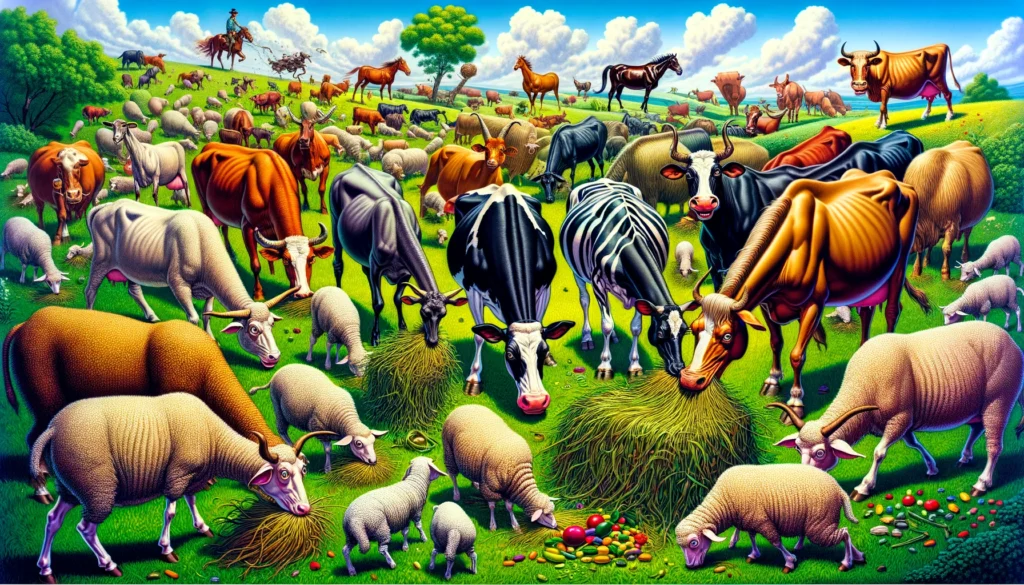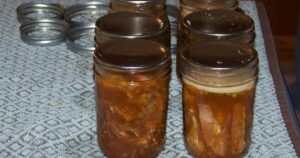
Grazing A vivid and detailed illustration in the exaggerated satirical style of Mad Magazine depicting various livestock animals grazing in a lush pasture. 1.webp.webp
Grazing
Definition:
Grazing refers to the consumption of pasture plants or forage vegetation by livestock animals, such as cattle, sheep, goats, horses, or buffalo, as a primary means of acquiring nutrition, sustenance, or dietary requirements in agricultural ecosystems. Grazing activities involve the selective or non-selective ingestion of grasses, legumes, herbs, shrubs, or browse plants by herbivores in natural grasslands, managed pastures, rangelands, or agroecosystems.
Description:
Grazing is a fundamental aspect of herbivore behavior and livestock production, enabling animals to obtain essential nutrients, energy, water, and minerals from vegetative biomass for growth, maintenance, reproduction, and lactation purposes. Grazing behavior varies among different livestock species, breeds, ages, genders, and physiological states, influenced by factors such as forage availability, quality, palatability, seasonality, weather conditions, and grazing management practices.
Fall off the barn roof and busted your keister? Life on the farm or ranch can be tough on the bum. Need a break? Laugh it off at FarmerCowboy.com, the #1 farm humor site. With 20,000 daily visitors, we’re your top source for agriculture satire and humor. Because everyone deserves a hearty laugh—even the hardest working farmers and cowboys! Join us and turn those long days into fun tales at FarmerCowboy.com.
Types of Grazing:
Grazing can be classified into several types based on grazing patterns, intensity, duration, or management strategies, including:
- Continuous Grazing: Allowing livestock animals unrestricted access to pasturelands or rangelands year-round, resulting in continuous grazing pressure, overgrazing, or selective foraging behavior, which may lead to pasture degradation, soil erosion, or loss of biodiversity in grazing ecosystems.
- Rotational Grazing: Dividing pasturelands into smaller paddocks, pastures, or grazing cells and rotating livestock animals systematically between different grazing areas on a scheduled basis, allowing forage recovery, rest periods, and regrowth while optimizing forage utilization, animal performance, and pasture productivity.
- Strip Grazing: Allocating narrow strips or lanes of pasture vegetation for livestock consumption in sequential order, moving temporary fences or electric wire barriers to control animal access, manage grazing intensity, and prevent pasture trampling, waste, or damage in intensive grazing systems.
- Mob Grazing: Concentrating large herds or groups of livestock animals in compact grazing areas for short periods, encouraging dense forage consumption, trampling, and manure deposition, stimulating soil fertility, organic matter decomposition, and pasture rejuvenation through holistic grazing management practices.
Grazing Management Practices:
Effective grazing management involves implementing strategies, techniques, and principles to optimize livestock performance, pasture productivity, and ecosystem sustainability, including:
- Stocking Rate: Adjusting livestock numbers, densities, or stocking rates based on carrying capacity, forage availability, and pasture carrying capacity to prevent overgrazing, underutilization, or degradation of grazing lands and maintain ecological balance in rangeland ecosystems.
- Graze Period: Rotating livestock animals between grazing areas or paddocks on a rotational basis, providing adequate rest periods, or recovery intervals for pastures to regenerate, replenish root reserves, and restore vegetative vigor, improving forage quality, persistence, and productivity over time.
- Graze Height: Monitoring and managing grazing intensity, sward height, or residual forage stubble to optimize forage utilization, minimize overgrazing, and promote regrowth, tillering, or tiller recruitment in grazing ecosystems, balancing livestock nutritional needs with pasture health and vigor.
- Grazing Distribution: Promoting even livestock distribution, grazing patterns, or utilization of pasture resources across grazing lands through water development, mineral supplementation, herding, or herding dog management, reducing pasture degradation, selective grazing, or overstocking in grazing systems.
Benefits of Grazing:
Grazing provides numerous benefits for livestock production, environmental conservation, and rural livelihoods, including:
- Nutrient Cycling: Grazing animals recycle nutrients, organic matter, and nitrogen through urine, feces, and trampling impacts, enhancing soil fertility, microbial activity, and nutrient cycling processes in grazing ecosystems, promoting plant growth, forage productivity, and carbon sequestration.
- Biodiversity: Grazing influences plant species composition, vegetation structure, and habitat diversity in grazing lands, creating mosaic landscapes, edge effects, or microhabitats that support native flora and fauna, pollinator populations, and wildlife biodiversity in agricultural ecosystems.
- Ecosystem Services: Grazing lands provide ecosystem services, such as soil conservation, water infiltration, flood mitigation, and wildlife habitat, contributing to watershed health, landscape connectivity, and ecosystem resilience in rural landscapes, providing ecological, social, and economic benefits for society.
- Livelihoods: Grazing supports rural livelihoods, pastoralism, and traditional livestock production systems, generating income, employment, and cultural heritage for pastoral communities, indigenous peoples, and smallholder farmers dependent on livestock farming, herding, or transhumance practices.
Conclusion:
Grazing is a vital component of sustainable livestock farming, pasture management, and ecosystem stewardship, promoting the efficient use of grazing lands, forage resources, and natural resources while supporting livestock nutrition, health, and welfare. By adopting sound grazing management practices, farmers can optimize livestock performance, pasture productivity, and ecosystem sustainability in grazing ecosystems, ensuring the long-term viability of livestock production systems and rural livelihoods.
References:
- Briske, D. D., et al. (2017). Adaptive management for rangeland stewardship. In Rangeland Systems (pp. 507-538). Springer.
- Holechek, J. L., et al. (2018). Grazing behavior. In Range Management: Principles and Practices (7th ed., pp. 229-264). Pearson.
- Teague, W. R., et al. (2016). The role of ruminants in reducing agriculture’s carbon footprint in North America. Journal of Soil and Water Conservation, 71(2), 156-164.
Originally posted 2021-08-09 23:30:37.
Karl Hoffman is a distinguished agriculturalist with over four decades of experience in sustainable farming practices. He holds a Ph.D. in Agronomy from Cornell University and has made significant contributions as a professor at Iowa State University. Hoffman’s groundbreaking research on integrated pest management and soil health has revolutionized modern agriculture. As a respected farm journalist, his column “Field Notes with Karl Hoffman” and his blog “The Modern Farmer” provide insightful, practical advice to a global audience. Hoffman’s work with the USDA and the United Nations FAO has enhanced food security worldwide. His awards include the USDA’s Distinguished Service Award and the World Food Prize, reflecting his profound impact on agriculture and sustainability.






